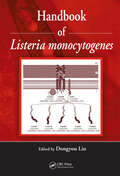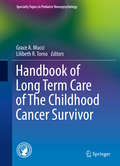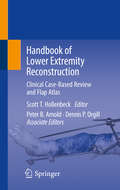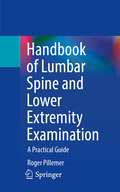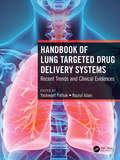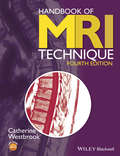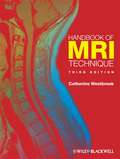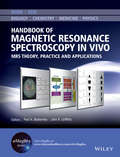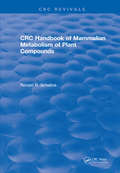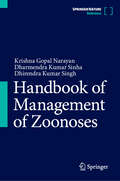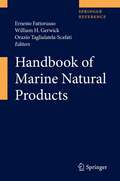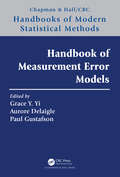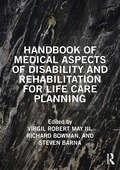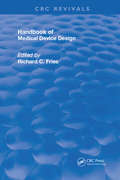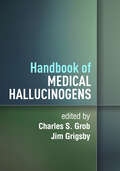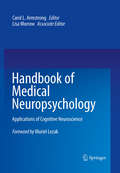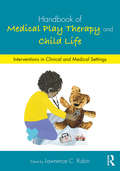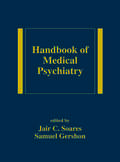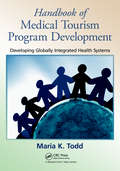- Table View
- List View
Handbook of Listeria Monocytogenes
by Dongyou LiuOnce feared as a deadly intracellular bacterium with the extraordinary capacity to survive a wide array of arduous external stressors, Listeria monocytogenes is increasingly recognized as a preferred vector for delivering anti-infective and anti-cancer vaccine molecules. A reliable, single-source reference on the fundamental aspects of
Handbook of Long Term Care of The Childhood Cancer Survivor
by Grace A. Mucci Lilibeth R. TornoThis authoritative reference examines in depth the myriad challenges facing pediatric cancer survivors and proposes a robust framework for structured follow-up of these patients through adulthood. Approaches to long-term follow-up include both established models of care and targeted models of lifelong surveillance of late effects by bodily systems and neurological outcomes. Sections devoted to quality of life and re-entry after treatment focus on key concerns such as health risk behaviors, school and career issues, psychological challenges, and care disparities. And a robust resources section adds extra usefulness to the expert coverage. Among the Handbook's topics: Developmental considerations in the transition from child and adolescent to adult survivorship. Long-term follow-up roadmaps by disease and treatment. Neuropsychological effects of pediatric brain tumors and associated treatment. Building resiliency in childhood cancer survivors: a clinician's perspective. School issues and educational strategies for survivors of childhood cancer. Educating and preparing the childhood cancer survivor for long-term care: a curriculum model for cancer centers. A work of rare scope, scholarship, and clinical acumen, the Handbook of Long-Term Care of the Childhood Cancer Survivor is a rewarding, practice-building resource essential to a wide range of healing professionals, including pri mary care physicians, pediatricians, oncologists, nurses, psychologists, neuropsychologists, child psychologists, and licensed therapists.
Handbook of Lower Extremity Reconstruction: Clinical Case-Based Review and Flap Atlas
by Dennis P. Orgill Scott T. Hollenbeck Peter B. ArnoldThis focused, concise book offers an in-depth analysis of lower extremity reconstruction alongside region-specific photos and illustrations. As an anatomical atlas, it seeks to aid the visual learner in showcasing the key steps in setting up and raising the flap for a given defect.Organized into two sections, opening chapters are arranged by general location, focusing specifically on the lower limb. Each general location of a wound is accompanied by an examination of relevant anatomy, including blood supply, nerve supply, arc of rotation of the tissue, and local flap options. Following a description of the anatomy, subsequent paragraphs explain the application of relevant local flap options. Section two incorporates flap demonstration and application into each chapter, offering a more detailed description, true and specific to each anatomical site of the technique.Supplemented by high-quality images and figures, Handbook of Lower Extremity Reconstruction: Clinical Case-Based Review and Flap Atlas is an invaluable reference for practicing plastic and orthopedic surgeons and residents in training.
Handbook of Lumbar Spine and Lower Extremity Examination: A Practical Guide
by Roger PillemerIn addition to complementary radiographic imaging, the physical exam is an essential diagnostic element for the orthopedic surgeon. As such, learning to perform this exam thoroughly is of utmost importance to medical students, residents and interns on an orthopedic rotation and in later practice.This practical text succinctly presents all of the necessary information regarding the physical examination of the lower extremity and lumbar spine. The lower spine, hip, knee, and foot and ankle are discussed in dedicated thematic sections, with each section comprised of three main chapters. The initial chapter describes the musculoskeletal anatomy and function of the joint, presenting the tests themselves along with the rationale for performing them. The second chapter presents the systematic examinations carried out in every case, and the third chapter describes examinations for specific conditions relating to the joint, including tendinopathies, osteoarthritis, neurological conditions, deformities and more. Plentiful bullet points and color images throughout the text describe and illustrate each test and physical sign.Convenient and user-friendly, Handbook of Lumbar Spine and Lower Extremity Examination is a valuable, portable guide to this all-important diagnostic tool for students and practitioners alike.
Handbook of Lung Targeted Drug Delivery Systems: Recent Trends and Clinical Evidences
by Yashwant PathakHandbook of Lung Targeted Drug Delivery Systems: Recent Trends and Clinical Evidences covers every aspect of the drug delivery to lungs, the physiology and pharmacology of the lung, modelling for lung delivery, drug devices focused on lung treatment, regulatory requirements, and recent trends in clinical applications. With the advent of nano sciences and significant development in the nano particulate drug delivery systems there has been a renewed interest in the lung as an absorption surface for various drugs. The emergence of the COVID-19 virus has brought lung and lung delivery systems into focus, this book covers new developments and research used to address the prevention and treatment of respiratory diseases. Written by well-known scientists with years of experience in the field this timely handbook is an excellent reference book for the scientists and industry professionals. Key Features: Focuses particularly on the chemistry, clinical pharmacology, and biological developments in this field of research. Presents comprehensive information on emerging nanotechnology applications in diagnosing and treating pulmonary diseases Explores drug devices focused on lung treatment, regulatory requirements, and recent trends in clinical applications Examines specific formulations targeted to pulmonary systems
Handbook of MRI Technique
by Catherine WestbrookNow entering its fourth edition, the market-leading Handbook of MRI Technique has been fully revised and updated to incorporate new technologies and developments essential to good practice. Written specifically for technologists and highly illustrated, it guides the uninitiated through scanning techniques and helps more experienced technologists to improve image quality.The first part of the book considers the main aspects of theory that relate to scanning and also includes practical tips on gating, equipment use, patient care and safety, and information on contrast media. The second half provides step-by-step instruction for examining each anatomical area, beginning with a basic anatomy section followed by sections on indications, patient positioning, equipment, artefacts and tips on optimizing image quality.Written by an international team of technologists from the United States, United Kingdom and EuropeSuitable for users for all types of MRI systemsNow includes key points throughout for quick referenceCompanion website at www.wiley.com/go/westbrook/mritechnique with self-assessment and image flashcardsHandbook of MRI Technique continues to be the ideal support both for radiographers new to MRI and for regular users looking for information on alternative techniques and suggestions on protocol modifications.
Handbook of MRI Technique
by Catherine WestbrookThe progress of magnetic resonance imaging (MRI) as a clinical tool has been extraordinary, out-stripping the rate of development of any other imaging technique. There has been a huge increase in the practical applications of MRI techniques and its uses look likely to extend even further with the development of high speed gradients and pulse sequences. The Handbook of MRI Technique has proved highly successful in guiding the uninitiated through scanning techniques and helping more experienced technologists to improve image quality. The third edition of this highly successful book has been fully revised and updated to consider new technologies and developments essential to good practice. The book is split into two parts. Part 1 considers the main aspects of theory that relate to scanning and also includes practical tips on gating, equipment use, patient care and safety, and information on contrast media. Part 2 provides step by step instruction for examining each anatomical area, beginning with a basic anatomy section, followed by sections on indications, patient positioning, equipment, artefacts and tips on optimizing image quality. A section of problem-solving exercises completes the book. Now in full color throughout with over 200 illustrations this book will continue to appeal to radiographers new to MRI and regular users who are looking for information on alternative techniques and suggestions on protocol modifications. Completely revised and updated Over 100 brand new photographs and line drawings Written by technologists for technologists With contributions from MRI technologists in the USA and Australia Suitable for users of all types of MRI systems
Handbook of MRI Technique
by Catherine WestbrookHANDBOOK OF MRI TECHNIQUE FIFTH EDITION Distinguished educator Catherine Westbrook delivers a comprehensive and intuitive resource for radiologic technologists in this newly revised Fifth Edition of the Handbook of MRI Technique. With a heavy emphasis on protocol optimisation and patient care, the book guides the uninitiated through scanning techniques and assists more experienced technologists with image quality improvement. The new edition includes up-to-date scanning techniques and an additional chapter on paediatric imaging. The latest regulations on MRI safety are referenced and there are expanded sections on slice prescription criteria. The book also includes the contributions of several clinical experts, walking readers through key theoretical concepts, discussing practical tips on cardiac gating, equipment use, patient care, MRI safety, and contrast media. Step-by-step instruction is provided on scanning each anatomical area, complete with patient positioning and image quality optimisation techniques. The book includes: A thorough introduction to the concepts of parameters and trade-offs, as well as pulse sequences, flow phenomena, and artefacts Comprehensive explorations of cardiac gating and respiratory compensation techniques, patient care and safety, contrast agents, and slice prescription criteria Practical discussions of a wide variety of examination areas, including the head and neck, spine, chest, abdomen, pelvis, the upper and lower limbs, and paediatric imaging A companion website with self-assessment questions and image flashcards Perfect for radiography students and newly qualified practitioners, as well as practitioners preparing for MRI-based certification and examination, the Handbook of MRI Technique will also prove to be an invaluable addition to the libraries of students in biomedical engineering technology and radiology residents.
Handbook of Magnetic Resonance Spectroscopy In Vivo: MRS Theory, Practice and Applications
by John R. Griffiths Paul A. BottomleyThis handbook covers the entire field of magnetic Resonance Spectroscopy (MRS), a unique method that allows the non-invasive identification, quantification and spatial mapping of metabolites in living organisms-including animal models and patients. Comprised of three parts: Methodology covers basic MRS theory, methodology for acquiring, quantifying spectra, and spatially localizing spectra, and equipment essentials, as well as vital ancillary issues such as motion suppression and physiological monitoring. Applications focuses on MRS applications, both in animal models of disease and in human studies of normal physiology and disease, including cancer, neurological disease, cardiac and muscle metabolism, and obesity. Reference includes useful appendices and look up tables of relative MRS signal-to-noise ratios, typical tissue concentrations, structures of common metabolites, and useful formulae. About eMagRes Handbooks eMagRes (formerly the Encyclopedia of Magnetic Resonance) publishes a wide range of online articles on all aspects of magnetic resonance in physics, chemistry, biology and medicine. The existence of this large number of articles, written by experts in various fields, is enabling the publication of a series of eMagRes Handbooks on specific areas of NMR and MRI. The chapters of each of these handbooks will comprise a carefully chosen selection of eMagRes articles. In consultation with the eMagRes Editorial Board, the eMagRes Handbooks are coherently planned in advance by specially-selected Editors, and new articles are written to give appropriate complete coverage. The handbooks are intended to be of value and interest to research students, postdoctoral fellows and other researchers learning about the scientific area in question and undertaking relevant experiments, whether in academia or industry. Have the content of this handbook and the complete content of eMagRes at your fingertips! Visit the eMagRes Homepage
Handbook of Mammalian Metabolism of Plant Compounds (CRC Press Revivals)
by Ronald R. SchelineHandbook of Mammalian Metabolism of Plant Compounds provides an extensive survey of how mammals metabolize compounds found in higher plants. Information about these compounds is important to researchers in pharmacology, toxicology, medical and natural products chemistry, and food sciences. Although there is plenty of literature about mammalian metabolism of plant compounds, it is scattered, and summaries of specific plant compounds are often difficult to obtain. This book contains 11 chapters discussing the metabolic fate of individual plant compounds grouped according to chemical class. It also features structural formulas of the compounds and their metabolites, including probable pathways of metabolism. This book provides a convenient single-volume reference source that will benefit all researchers requiring this type of information.
Handbook of Management of Zoonoses
by Krishna Gopal Narayan Dharmendra Kumar Sinha Dhirendra Kumar SinghThis book reviews the etiology of major zoonotic diseases, their impact on human health, and control mechanisms for better management. It also examines factors influencing transmission, diagnosis, treatment, management, and prevention of zoonotic diseases caused by different human pathogens, including bacteria, viruses, fungi, protozoans, and parasites. It also introduces zoonoses with a wildlife reservoir and discusses different transmission modes, and factors that influence the epidemiology of zoonoses. It further discusses the holistic strategies for the cost-effective prevention and control of these zoonoses. Towards the end, the book also discusses infections that have spread from non-human primates to humans and strategies to improve disease control and elimination. This book is very useful for students, academicians, and researchers of veterinary sciences, veterinary medicine, and, veterinary public health.
Handbook of Marine Natural Products
by Ernesto Fattorusso Orazio Taglialatela-Scafati William H. Gerwick"Handbook of Marine Natural Products" takes a fresh approach to describing the major themes of research in this rapidly developing field. This two volume reference work begins with a section that provides a taxonomic survey of the secondary metabolites of diverse marine life including microbes, algae, and invertebrates. This is followed by a demonstration of the techniques and strategies employed in modern structure elucidation of complex natural products. The natural roles of marine natural products are then explored in a series of focused chapters which include the topics of symbiosis, anti-predation and antifouling, chemical interactions, and defence against UV stress. Various routes which facilitate the understanding of marine natural product biosynthesis are subsequently explained and these are followed by an extensive set of chapters on the biomedical potential of marine natural products. The latter portion of this section considers the technologies and scientific disciplines necessary for advancing bioactive marine natural product lead compounds into actual pharmaceuticals. The reference work finishes with a selection of chapters describing marine toxins and their impact on public health and seafood resources. Final thoughts presented at the end of the second volume focus on the future of this field of investigation and discovery research. This publication is presented as a reference handbook and general concepts are emphasized and illustrated with numerous interesting examples, graphical information, and a comprehensive index. "Handbook of Marine Natural Products" introduces students who are at advanced undergraduate and entry graduate student levels to this fascinating multidisciplinary field. It is an ideal desk companion for courses focusing on this contemporary area.
Handbook of Material Engineering in Nanobiomedicine and Diagnostics
by Pranjal Chandra Uday Pratap AzadThe book is about the application of nanotechnology in the field of medicine, with a focus on diagnosis and therapy. The first few chapters introduce the basics of material engineering and nanobiomedicine, followed by chapters on different types of engineered nanomaterials and their surface modification strategies for biomedicine. The book then covers the application of nanobiomedicines and nanodiagnostics in clinical settings, and how functionalized nanomaterials can be used in microfluidic biosensors and diagnosis devices. The latter half of the book discusses various nanobiomaterials used in cancer diagnosis and therapy, as well as regenerative medicine, infectious diseases, and bioimaging. The book concludes with a chapter on the commercial aspects of nanobiomedicines.
Handbook of Mathematical Methods in Imaging
by Otmar ScherzerThe Handbook of Mathematical Methods in Imaging provides a comprehensive treatment of the mathematical techniques used in imaging science. The material is grouped into two central themes, namely, Inverse Problems (Algorithmic Reconstruction) and Signal and Image Processing. Each section within the themes covers applications (modeling), mathematics, numerical methods (using a case example) and open questions. Written by experts in the area, the presentation is mathematically rigorous. The entries are cross-referenced for easy navigation through connected topics. Available in both print and electronic forms, the handbook is enhanced by more than 150 illustrations and an extended bibliography. It will benefit students, scientists and researchers in applied mathematics. Engineers and computer scientists working in imaging will also find this handbook useful.
Handbook of Measurement Error Models (Chapman & Hall/CRC Handbooks of Modern Statistical Methods)
by Grace Y. YiMeasurement error arises ubiquitously in applications and has been of long-standing concern in a variety of fields, including medical research, epidemiological studies, economics, environmental studies, and survey research. While several research monographs are available to summarize methods and strategies of handling different measurement error problems, research in this area continues to attract extensive attention. The Handbook of Measurement Error Models provides overviews of various topics on measurement error problems. It collects carefully edited chapters concerning issues of measurement error and evolving statistical methods, with a good balance of methodology and applications. It is prepared for readers who wish to start research and gain insights into challenges, methods, and applications related to error-prone data. It also serves as a reference text on statistical methods and applications pertinent to measurement error models, for researchers and data analysts alike. Features: Provides an account of past development and modern advancement concerning measurement error problems Highlights the challenges induced by error-contaminated data Introduces off-the-shelf methods for mitigating deleterious impacts of measurement error Describes state-of-the-art strategies for conducting in-depth research
Handbook of Media for Clinical Microbiology
by Ronald M. Atlas James W. SnyderWhile evolving molecular diagnostic methods are being heralded for the role they will play in improving our ability to cultivate and identify bacteria, fungi, and viruses, the reality is that those new methods are still beyond the technical and financial reach of most clinical laboratories. Most clinical microbiology laboratories still rely upon cu
Handbook of Media for Clinical and Public Health Microbiology
by Ronald M. Atlas James W. SnyderThe detection and/or isolation and identification of pathogenic microorganisms is critical for the laboratory diagnosis of infectious diseases. With growth-dependant methods providing reliable means for identifying pathogens, traditional culturing continues to play an integral role in the detection and characterization of known and "new" microbial
Handbook of Medical Aspects of Disability and Rehabilitation for Life Care Planning
by Richard Bowman Steven Barna Virgil Robert May IIIThis textbook is an essential resource for life care planners in understanding and assessing a range of medical disabilities, life care planning as a health care service delivery practice, certification under the International Commission on Health Care Certification, and the path to rehabilitation for mild to catastrophic injuries.Written by a team composed of expert physicians and doctoral-level practitioners, the book covers the key areas of traumatic injury and resultant disability that life care planners so often face. From acquired brain injury and spinal disorders to amputation, chronic pain, posttraumatic debilitating headaches, and plastic reconstructive surgery, the book provides a road map not only to the treatment options available but also the strategies that can lead to rehabilitation and a possible return to work. Each chapter also discusses possible complications, allowing a holistic perspective on each issue.Also including chapters on medical cost projection analysis and functional capacity evaluation, this is the complete text for both professionals in the fields of rehabilitation services and life care planning, as well as students training to qualify.
Handbook of Medical Device Design
by Richard C. FriesThe Handbook of Medical Device Design provides a review of regulatory and standards issues in medical device design, including FDA regulations, types of 510 (k), the ISO 9000 series, and medical device directives. It identifies how to determine and document customer needs and device requirements. It also establishes reliability and qua
Handbook of Medical Device Design (Routledge Revivals)
by Richard C. FriesFirst published in 2001: This handbook has been written to give those professionals working in the development and use of medical devices practical knowledge about biomedical technology, regulations, and their relationship to quality health care.
Handbook of Medical Hallucinogens
by Charles S. Grob and Jim GrigsbyThis handbook reviews promising applications of psychedelics in treatment of such challenging psychiatric problems as posttraumatic stress disorder, major depression, substance use disorders, and end-of-life anxiety. Experts from multiple disciplines synthesize current knowledge on psilocybin, MDMA, ketamine, and other medical hallucinogens. The volume comprehensively examines these substances' neurobiological mechanisms, clinical effects, therapeutic potential, risks, and anthropological and historical contexts. Coverage ranges from basic science to practical clinical considerations, including patient screening and selection, dosages and routes of administration, how psychedelic-assisted sessions are structured and conducted, and management of adverse reactions.
Handbook of Medical Neuropsychology
by Carol L. Armstrong Lisa MorrowThe recent surge of interest in the neuroscience of autism, HIV/AIDS, cancer, Alzheimer's, and other disorders has brought with it an increasing awareness of the effects of medical conditions on the brain and behavior--an awareness extending through the research and practice arenas, among those working with pediatric and adult clients alike. Comprehensive in scope and highly detailed in its coverage, the Handbook of Medical Neuropsychology is organized to give readers knowledge of the field, whether one needs to understand a clinical evaluation, design a research study, or gain a deeper understanding of disease processes and corresponding behaviors. Featuring the most up-to-date information on cognitive neuroscience to enhance the work of the practitioner, the student, or the researcher, the book handles theory, historical background, practical considerations, and controversial areas with clear explanations, clinical expertise, and real-world insight, and critiques diagnostic and assessment tools specific to disorders. The wide selection of commonly seen and rarely encountered diagnoses covered includes: Primary nervous system disease and injury. Vascular system disease. Developmental, genetic, and structural disorders. Dementia and normal aging. Immune-related disorders. Endocrine disease. Metabolic conditions. Plus a chapter on current and emerging approaches to rehabilitation. Opening out a specialty as it grows in importance, the Handbook of Medical Neuropsychology is an essential resource for the neuropsychology clinician, researcher, or graduate student.
Handbook of Medical Play Therapy and Child Life: Interventions in Clinical and Medical Settings
by Lawrence C. RubinThe Handbook of Medical Play Therapy and Child Life brings together the voices and clinical experiences of dedicated clinical practitioners in the fields of play therapy and child life. This volume offers fresh insights and up to date research in the use of play with children, adolescents, and families in medical and healthcare settings. Chapters take a strength-based approach to clinical interventions across a wide range of health-related issues, including autism, trauma, routine medical care, pending surgeries both large and small, injury, immune deficiency, and more. Through its focus on the resiliency of the child, the power of play, and creative approaches to healing, this handbook makes visible the growing overlap and collaboration between the disciplines of play therapy and child life.
Handbook of Medical Psychiatry
by Samuel Gershon Jair C. SoaresThis volume examines attempts to identify genetic risk factors and environmental components contributing to the development of psychiatric disorders. It explores the symptoms, courses, outcomes, treatment responses and aetiologies of a range of psychiatric illnesses to improve disease classification schemes.
Handbook of Medical Tourism Program Development: Developing Globally Integrated Health Systems
by Maria K. ToddExplaining how to develop a patient-centered medical tourism program, the Handbook of Medical Tourism Development is the ideal guide for any hospital, clinic, hotel, spa, or ancillary facility wishing to become a medical tourism provider. From high-cost surgery, transplants, diagnostics, and preventive wellness checkups, to medical and wellness spa
